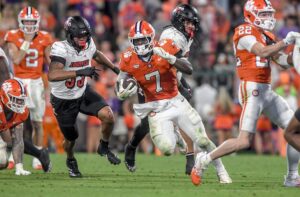Wisconsin Football Recruiting
There are two ways to be very good at College Football.
- You recruit at such a high caliber that most other schools cannot compete with you (ie, Alabama, Ohio State, Clemson, Georgia, etc)
- You develop your recruits through four to five years, striking gold on a few hidden gems, but generally relying on structure, program culture, and a little bit of luck.
The Wisconsin Badgers live largely in the latter category. That is not to say as a slight. Since Barry Alvarez arrived in 1990 as head football coach, the culture of Wisconsin football was changed for good. Winning became common, but maybe more importantly, it became expected.
Like every good program, Wisconsin forged an identity. As a state school, they embodied what their state provided in football.
Big, strong, and burly football players. And it has worked. Over the last 30 years, the Badgers have six conference championships, seven Rose Bowl appearances, and more than a dozen All-Americans. On top of that, the production of NFL talent out of Madison has skyrocketed and sits at 31 players currently active.
This success has catapulted the Badgers into the national conversation. With that success, expectations rise. When expectations rise, there comes increased exposure. Where there is exposure, there comes recognition. Right now, Wisconsin sits just behind the top tier in the Big Ten based on expectations, exposure, and recognition. While it’s fair to say they’re above the likes of Iowa and Nebraska right now, it is equal to say they’re a ways behind Ohio State, Michigan, and Penn State as a brand. Most notably, the Buckeyes.
Where Wisconsin Stands Recruiting
Wisconsin is not a recruiting powerhouse. As noted, they thrive in development, structure, and overall program culture. Some of this is expected. Recruiting in college football is dictated by the powers in the sport. Regional powers like Ohio State, Michigan, and Notre Dame have the most success recruiting in this part of the country. Their athleticism in the trenches and outside skill positions outclasses every Badger team. However, where the Badgers have been able to compete for the best with these schools is in the trenches. Even with a significant discrepancy in talent.
In 2011, the recruiting class for a Badger team coming off its first Rose Bowl appearance in a decade was .8309. In 2014, the incoming recruiting class averaged a rating of .8478. Both of those average out to a mid-tier three-star prospect, and averaged 7th total in the Big Ten. And still, the Badgers found a way not to just win, but outperform the ratings and talent on the roster that on paper would suggest otherwise.
Furthermore, each of these teams that followed would have a ceiling. In the span of 2011-2015, Wisconsin went 2-10 vs Ohio State, the SEC, and bowl games combined. The common Achilles heel? Athleticism. While they would perform well in the trenches, have a great running back, and a dependable defense, their capabilities were maxed out at 9-10 win seasons. For most programs, that’s not just acceptable, but rather incredible. However, it can create a sense of complacency, which no fan base can tolerate. With that being said, since Paul Chryst came to Madison in the winter of 2014, Wisconsin has seen an exponential rise in recruiting.
Now, entering Chryst’s seventh year as Head Coach, the Badgers last three recruiting classes go like this (per 247 sports):
2019: .8786
2020: .8783
2021: .8904
Of this group, two are five stars, and 14 have a grade of .90 or higher. Culminating with 2021’s record-setting class, recruiting for the Wisconsin football program has clearly never been in a better place. This class ranks third overall in the Big Ten, and 15th nationally. Clearly, the Badgers are taking the next step as a regional power in recruiting.
What This Means
As shown, the average recruiting class rating for Wisconsin has grown nearly six full points in the last decade. Of the 14 highest-rated recruits in the last four years, half are offensive lineman. Every great program in college football has its foundation in the interior. While Wisconsin did well developing here, the weakness of previous iterations of lineman was lacking in true athleticism and explosiveness. With new incomers like five-star Nolan Rucci joining highly touted recruits like previous five-star Logan Brown, and fellow Top 100 recruit Trey Wedig, the Badgers now sport the athleticism to take on powers like the Buckeyes, Wolverines, and Nittany Lions in the trenches.
Although it is important to tout this, it should be noted much more will be needed to take the next step as a regional power. This takes Chryst and company one step closer to truly competing with the likes of Ohio State, Michigan, and Penn State on a year to year basis, but more is needed. To further raise the ceiling of expectations, this recruiting success will have to expand into skill position players. As seen with the recruitments of Graham Mertz and Jalen Berger, the capacity is there. Now, they’ll have to continue it.
For the better part of the last 30 years, the Badgers have outperformed their ratings, rankings, projections, whatever you have. Through structure, development, and culture, the foundation has been set. This foundation is the core principle to providing success for years to come. Nevertheless, the previous ceiling that hung above Wisconsin teams in the past is starting to see cracks. If the recruiting trends maintain their growth, Wisconsin should not only raise that ceiling but break through it.






